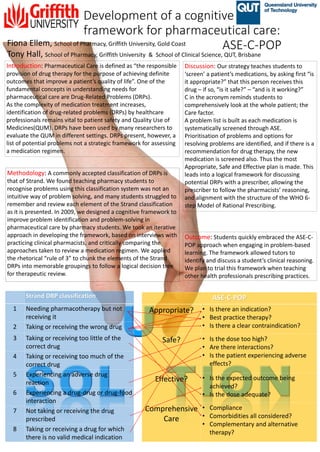
ASE-C-POP cognitive framework for identifying drug therapy problems
- 1. Development of a cognitive framework for pharmaceutical care: ASE-C-POP Introduction: Pharmaceutical Care is defined as “the responsible provision of drug therapy for the purpose of achieving definite outcomes that improve a patient’s quality of life”. One of the fundamental concepts in understanding needs for pharmaceutical care are Drug-Related Problems (DRPs). As the complexity of medication treatment increases, identification of drug-related problems (DRPs) by healthcare professionals remains vital to patient safety and Quality Use of Medicines(QUM). DRPs have been used by many researchers to evaluate the QUM in different settings. DRPs present, however, a list of potential problems not a strategic framework for assessing a medication regimen. Strand DRP classification 1 Needing pharmacotherapy but not receiving it 2 Taking or receiving the wrong drug 3 Taking or receiving too little of the correct drug 4 Taking or receiving too much of the correct drug 5 Experiencing an adverse drug reaction 6 Experiencing a drug-drug or drug-food interaction 7 Not taking or receiving the drug prescribed 8 Taking or receiving a drug for which there is no valid medical indication ASE-C-POP Appropriate? • Is there an indication? • Best practice therapy? • Is there a clear contraindication? Safe? • Is the dose too high? • Are there interactions? • Is the patient experiencing adverse effects? Effective? • Is the expected outcome being achieved? • Is the dose adequate? Comprehensive Care • Compliance • Comorbidities all considered? • Complementary and alternative therapy? Fiona Ellem, School of Pharmacy, Griffith University, Gold Coast Tony Hall, School of Pharmacy, Griffith University & School of Clinical Science, QUT, Brisbane Discussion: Our strategy teaches students to ‘screen’ a patient’s medications, by asking first “is it appropriate?” that this person receives this drug – if so, “is it safe?” – “and is it working?” C in the acronym reminds students to comprehensively look at the whole patient; the Care factor. A problem list is built as each medication is systematically screened through ASE. Prioritisation of problems and options for resolving problems are identified, and if there is a recommendation for drug therapy, the new medication is screened also. Thus the most Appropriate, Safe and Effective plan is made. This leads into a logical framework for discussing potential DRPs with a prescriber, allowing the prescriber to follow the pharmacists’ reasoning, and alignment with the structure of the WHO 6- step Model of Rational Prescribing. Outcome: Students quickly embraced the ASE-C- POP approach when engaging in problem-based learning. The framework allowed tutors to identify and discuss a student’s clinical reasoning. We plan to trial this framework when teaching other health professionals prescribing practices. Methodology: A commonly accepted classification of DRPs is that of Strand. We found teaching pharmacy students to recognise problems using this classification system was not an intuitive way of problem solving, and many students struggled to remember and review each element of the Strand classification as it is presented. In 2009, we designed a cognitive framework to improve problem identification and problem-solving in pharmaceutical care by pharmacy students. We took an iterative approach in developing the framework, based on interviews with practicing clinical pharmacists, and critically comparing the approaches taken to review a medication regimen. We applied the rhetorical “rule of 3” to chunk the elements of the Strand DRPs into memorable groupings to follow a logical decision tree for therapeutic review.